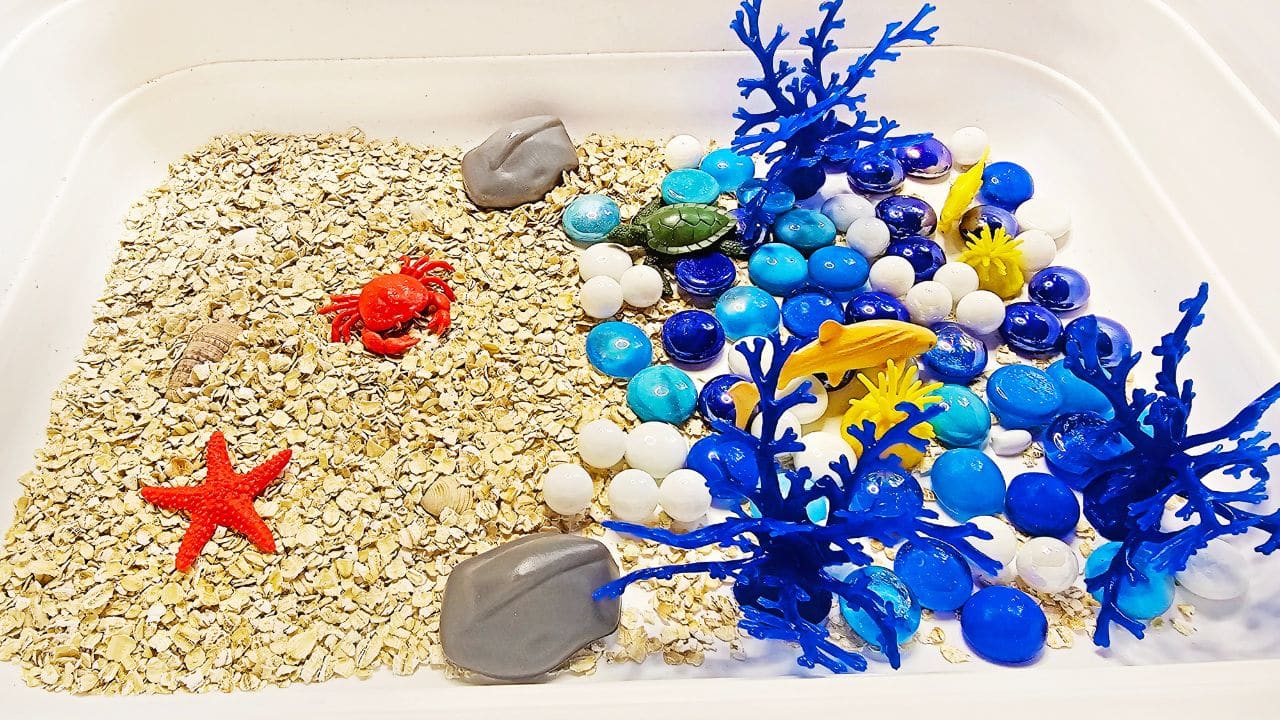Everyone loves the beach. There’s the sound of the waves, the feel of sand between your fingers, and the excitement of spotting seashells or tiny creatures along the shore. It’s relaxing, playful, and full of opportunities to explore.
This beach sensory bin brings that experience home. With smooth marbles, soft oats, ocean animals, and buried treasures, kids can dive into hands-on play that feels like a seaside getaway…without ever leaving the house.
Supplies and Materials
Everything in this sensory bin is simple, safe, and easy to find. You might already have most of it at home. Be sure to customize it based on your child’s age or interests, making it as simple or detailed as you like.
- Toy Ocean Animals – Include sea turtles, dolphins, crabs, and fish to spark storytelling and learning.
- Seashells – These can be buried for discovery or used to discuss different shell shapes and animals that live in them.
- Blue Flat Glass Marbles – Represent the water and give a cool, smooth texture for sensory contrast.
- White Marbles – Great for imaginative play as turtle eggs or pearls.
- Oats – Provide a sand-like texture that’s soft, safe, and easy to clean up.
- Scoop (optional) – Encourages digging, pouring, and developing hand-eye coordination.
How to Make the Beach Sensory Bin

Setting up your beach sensory bin is quick and easy, with just a few materials and a little creativity. In a few quick steps, you can create a mini shoreline that’s perfect for play and exploration.
- Cover the bottom half of the bin with oats representing the sand. Cover the other half with the flat glass marbles.
- Bury the seashells in the oats for kids to dig and find.
- Set up the ocean animals in the section with the marbles.
- Kids can pretend the white marbles are turtle eggs. This is an excellent opportunity to discuss how sea turtles come to the shore to lay eggs.
- Another option for the white marbles is pretending they are pearls.
- Discuss what animals can breathe air (turtles, dolphins), which breathe only water (fish), and which can breathe on both land and water (crabs.)
- Teach responsible beach use by making a pool on the land and showing how sea animals can become trapped.
How to Use This Bin for Learning

What I love about sensory bins is that they’re bigger than just something fun to keep the kids busy. They’re full of natural learning learning opportunities.
From early science concepts to storytelling and fine motor practice, every scoop and shell can spark curiosity. Here are a few simple ways to turn playtime into a meaningful learning experience:
- Encourage Sorting and Categorizing: Ask your child to group the animals by where they live (land vs. sea), or sort the shells by size, shape, or color.
- Spark Storytelling: Let them create stories with the ocean animals—What’s the dolphin doing today? Who found the hidden pearl? This builds language and creativity.
- Introduce Science Concepts: Talk about which animals breathe air (like dolphins and turtles), which live entirely underwater, and which ones move between land and sea (like crabs).
- Teach Environmental Awareness: Show how a turtle could get stuck in a small pool or how pollution could affect the animals. It’s a gentle way to start talking about caring for the planet.
- Practice Fine Motor Skills: Scooping oats, burying shells, and placing marbles are all great for hand strength, coordination, and focus.
Other Fun Nature Sensory Bins You’ll Enjoy
- Firefly catching sensory bin
- Bug Hotel sensory bin
- Sparkling mermaid bait sensory bin
- Big creek sensory bin
Frequently Asked Questions
What age is this activity best for?
This beach sensory bin is great for ages 3 and up. Always supervise younger children, especially around small items like marbles or shells.
Can I use something other than oats for sand?
Yes! You can use kinetic sand, colored rice, or even cornmeal depending on what you have. Oats are just a soft, mess-free option that’s easy to clean.
What if I don’t have marbles?
Try blue dyed rice, aquarium gravel, or even crinkled blue tissue paper to simulate water. White beans can also work well as a substitute for pearls or eggs.
Can I take this sensory bin outside?
Absolutely! It’s a great outdoor activity—just lay down a blanket or set it on a table, and cleanup becomes even easier.
How do I keep kids engaged for longer?
Add simple challenges like: Can you find three shells? or Make a story about what your dolphin is doing. Open-ended questions and role-play invitations keep their imagination flowing.

Leave a Reply